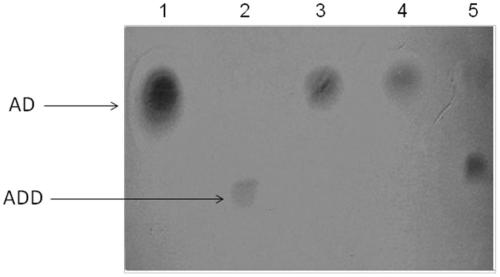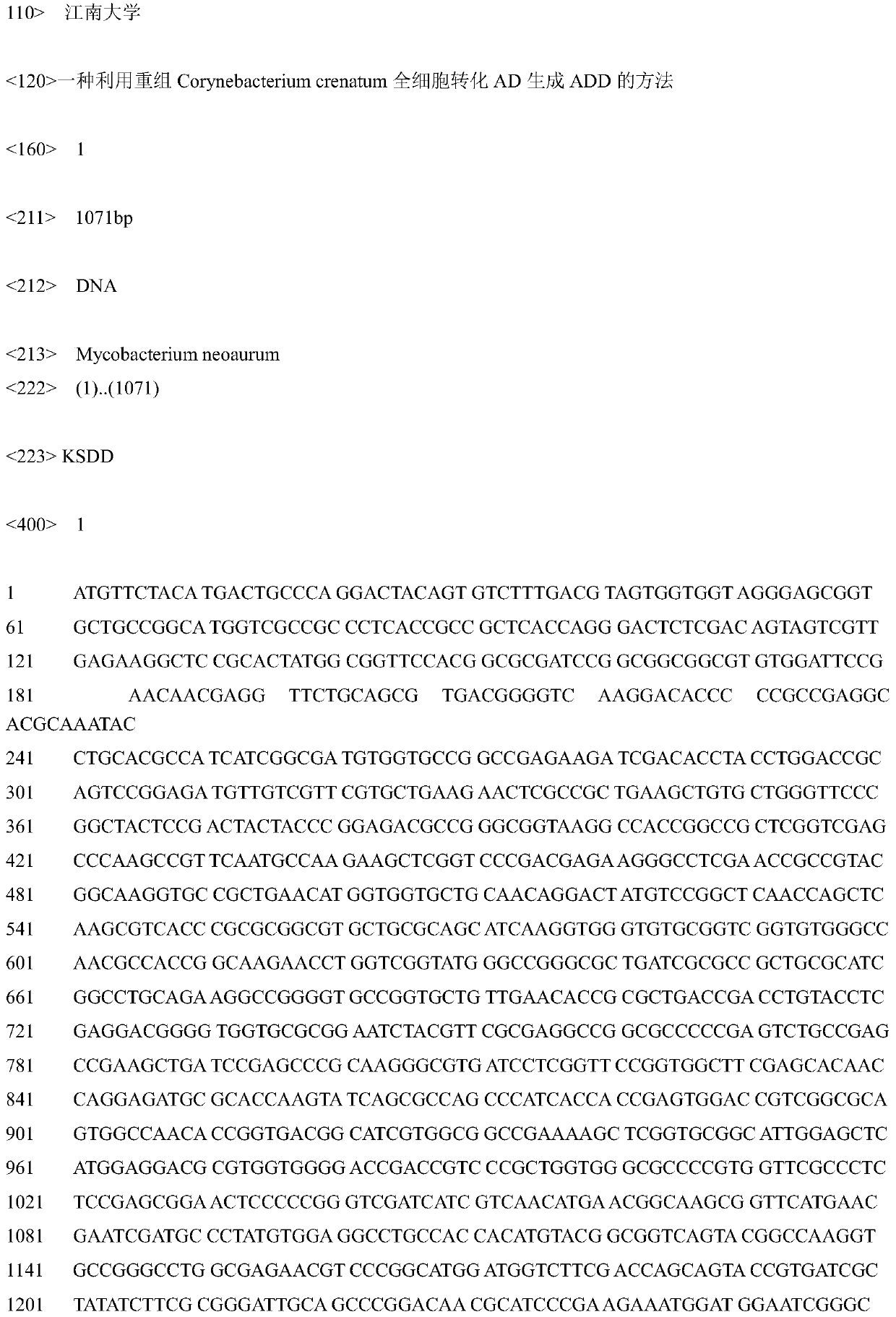A method for transforming AD into ADD by using recombinant corynebacterium crenatum whole cells
A whole-cell transformation and 4-AD technology, applied in the fields of genetic engineering and enzyme engineering, can solve the problems that hinder the optimization of whole-cell transformation conditions and the lack of understanding of enzymatic properties, and achieve environmental protection, easy promotion and application, and raw materials The effect of high utilization
- Summary
- Abstract
- Description
- Claims
- Application Information
AI Technical Summary
Problems solved by technology
Method used
Image
Examples
Embodiment 1
[0038] Embodiment 1: Construction of recombinant Corynebacterium crenatum strain
[0039] Take the lab with 3-sterone-△ 1 - The new mycobacterium aureus with dehydrogenase activity is used as the starting strain, and its chromosome is used as a template to obtain the gene of the enzyme by means of PCR, and connect the cloning vector to realize a large amount of amplification of the gene. A large number of amplified KSDD gene fragments were purified and connected to the pXMJ19 vector. After successful verification, the model strain Corynebacterium blunt-toothed SYPA5-5 was transformed. Positive transformants were screened on resistance plates, inoculated in shake flasks for fermentation, and the product ADD in the fermentation broth was detected by TLC and HPLC. The recombinant strains with the ability to transform AD into ADD were successfully constructed if the product ADD was detected. The present invention finally obtains the recombinant corynebacterium bacilli that trans...
Embodiment 2
[0040] Embodiment 2: the enzyme activity assay of recombinant bacterial strain
[0041] The strain was cultured overnight in LBG medium, centrifuged at 8000rpm for 10min, washed 3 times with 50mM Tris-HCL buffer solution of pH 7.0, suspended in the buffer solution, and subjected to sonication to prepare crude enzyme solution. 1ml reaction mixture was composed of 100 μL crude enzyme solution, 50 mM Tris-HCL (pH7.0), 40 μM 2,6-dichlorophenol indophenol, 1.5 mM phenazine methyl sulfate, 500 μM AD (dissolved in 2% methanol) The composition was reacted at 30°C for 50 minutes, and the change of absorbance value at a wavelength of 600nm was detected. The amount of enzyme that can cause a change of 0.01 absorbance unit per minute is defined as a unit U. The measured enzyme activity of the recombinant strain was 2.58U / mg.
[0042] The crude enzyme liquid was purified by Ni-NTA column to obtain pure KSDD. The specific enzyme activity of the purified enzyme liquid was 12.96U / mg, and th...
Embodiment 3
[0055] Example 3: Detection of whole cell transformation performance of recombinant strains
[0056] Inoculate the recombinant Corynebacterium blunt-toothed into 50ml LBG medium with 1% inoculum, cultivate for 24h, recover the thalline by centrifugation, wash twice, redissolve with the appropriate 50mM Tris-HCL (pH7.0) buffer, add 1% (w / v) 4-AD and 3% (w / v) β-cyclodextrin, continue to culture at 30°C, 160rpm for 12h. After detection and analysis by HPLC, the molar conversion rate of the final substrate reaches 83.87%, which is about 23 times higher than that of the starting bacteria.
[0057]
[0058]
PUM
 Login to View More
Login to View More Abstract
Description
Claims
Application Information
 Login to View More
Login to View More - R&D
- Intellectual Property
- Life Sciences
- Materials
- Tech Scout
- Unparalleled Data Quality
- Higher Quality Content
- 60% Fewer Hallucinations
Browse by: Latest US Patents, China's latest patents, Technical Efficacy Thesaurus, Application Domain, Technology Topic, Popular Technical Reports.
© 2025 PatSnap. All rights reserved.Legal|Privacy policy|Modern Slavery Act Transparency Statement|Sitemap|About US| Contact US: help@patsnap.com



